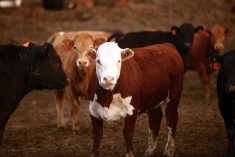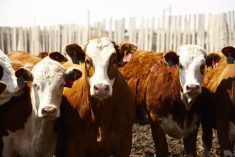There has been lots said lately about added steroids in beef.
Although steroids are used for very specific treatments regarding specific conditions, their use if anything is minimal and has been greatly reduced even further with the NSAIDs (non-steroidal anti-inflammatory drugs). This article will go over specific uses where steroids produce beneficial results to our livestock industry and are used for at most two to three days in most circumstances.
Steroids are produced by the adrenal gland in normal mammals and released in stressful situations. That is why in research, a measuring stick for stress can be salivary cortisol (a specific steroid). The ones used, and approved for use, in veterinary medicine are slight variations of this molecule with slightly different properties.
Read Also

Mosquito-borne virus could be devastating to sheep breeding operations
Cache Valley virus, a mosquito-borne disease that infects small ruminants, could be a devastating hit to small operations.
Veterinarians recognize the advantages of each and use them appropriately yet very conservatively. They were, at one time, administered along with antibiotics to reduce the inflammation in lungs with pneumonia. But since steroids can be immunosuppressive, they have been pretty much replaced with NSAIDs.
Steroids are not prescription medications but veterinarians treat them as such, so are prescribed when they know there will be a benefit to give them. There are also some contra-indications, which is why NSAIDs have currently taken over many of the former uses of steroids.
About the only time they are given en masse in the feedlots is as an abortifacient (abortion-causing drug). They are used here in combination with a prostaglandin to ensure very close to a 100 per cent abortion rate. It is for this reason that when used for other purposes, a veterinarian must warn of the possibility of aborting in pregnant animals. Calving is initiated from cortisol coming from the fetal adrenal gland, so using the steroids to initiate calving mimics this process. Sometimes steroids and prostaglandins are given to every heifer in the feedlot, and sometimes veterinarians will palpate the heifers and only use the products on the pregnant ones. Either way one shot of this combination relieves many calving-related problems later on in underage heifers.
This is a huge benefit to animal welfare. This is a necessary step as many young heifers exposed to bulls breed much too early and this is why this problem even exists. I have not looked at the numbers, but my guess is the bulk of steroids are used as a one-time event, long before slaughter is even thought about. Some steroids have actual slaughter withdrawals as short as four days, so they are generally eliminated fairly quickly.
There are only a few individual uses of steroids in production animals and one of these is in allergic reactions.
Because steroids are immunosuppressive they decrease the immune response in an allergic reaction and reduce the fluid accumulation and swelling. In severe cases, of course, epinephrine will be used along with this. Steroids in these cases can save animals’ lives and may be repeated in short order, but only for a day or so.
A type of respiratory condition called AIP (similar to high-altitude disease) is another reason for using steroids. Given, in many cases, with antihistamines, these two products may help. But talk to your veterinarian about the diagnosis and specific treatments they recommend for these types of respiratory conditions. They may recommend this same treatment for viral causes of pneumonia, such as BRSV or IBR, and often antibiotics are given concurrently to prevent secondary infection.
I believe steroids get the bad rap because in human and small-animal medicine they are used in the treatment of many chronic skin conditions and hyperimmune responses and once the body becomes reliant on them, the adrenal gland starts to shut down. So once on longer-term treatments you cannot stop them cold turkey but must gradually decrease the dosage to allow the adrenal gland to increase production again. With such short-term treatment in production animal medicine this is almost never the case.
In summary, steroids — although used very sparingly in veterinary medicine in large-animal production — are necessary products we need to have access to. A large number of former uses have been replaced by NSAIDs, but there are certain conditions where steroids are still the drugs of choice so clinics will carry a small inventory.
Statements by some fast-food chains, such as ones by A&W, that imply that beef has added steroids are misleading. If they are used in rare instances, withdrawal times are relatively short since they are excreted relatively quickly. Always use them, when necessary, on the advice from your veterinarian.
















